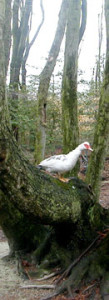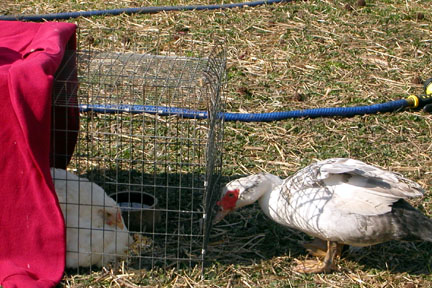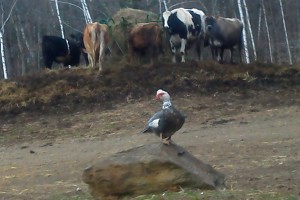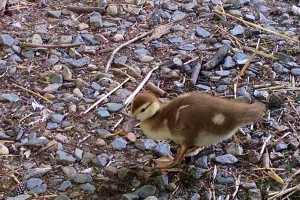They came by night. As I’ve previously described, two ducks, six ducklings, four hens, two roosters and one very terrified turkey arrived at the original site of the sanctuary back in 2002 or 2003, having been saved from the livestock auction block by a rescuer of feral cats.
One of the ducklings stood out from the crowd immediately, due to her air of self-possession and her habit of perching on fence poles and tree trunks to look out into the distance. We called the white bird with grey-smudged wings Seagull, not only because she resembled those seabirds but also because she did seem to feel as free as any wild bird.
 We respected her self-determination insofar as possible, given our responsibility to keep her safe in a habitat so far from the native lands of her wild ancestors. (The wild ducks from whom the only ever partially “domesticated” Muscovy ducks descend sleep in South American trees, using their long claws both as weapons and aids in perching. Post-conquest, they have been forcibly bred for meat and for show as well as used to breed the sterile “mule ducks” preferred by the foie gras and duck meat industries.) I did have to insist, one night, that she and her mother come into the coop rather than float in a creek where their white feathers would be beacons for owls. And then there was the time I had to literally unwrap a black snake from around Seagull’s neck and body, after which point I insisted that she refrain from nesting in the woodshed.
We respected her self-determination insofar as possible, given our responsibility to keep her safe in a habitat so far from the native lands of her wild ancestors. (The wild ducks from whom the only ever partially “domesticated” Muscovy ducks descend sleep in South American trees, using their long claws both as weapons and aids in perching. Post-conquest, they have been forcibly bred for meat and for show as well as used to breed the sterile “mule ducks” preferred by the foie gras and duck meat industries.) I did have to insist, one night, that she and her mother come into the coop rather than float in a creek where their white feathers would be beacons for owls. And then there was the time I had to literally unwrap a black snake from around Seagull’s neck and body, after which point I insisted that she refrain from nesting in the woodshed.
After her mother died, Seagull assumed the role of the hub of her family, attended by both her siblings and her father. If we needed the gang to go in for the night or shift to a different foraging area, all that we had to do was convince Seagull and the others would follow. Seagull also played a leadership role within our multispecies community, frequently poking her beak into other birds’ business. She sometimes doted on young refugees from the surrounding poultry farms, and she frequently intervened when roosters became rowdy.
One day, I was out in the foraging yards, supervising the rehabilitation of a former fighting rooster. We had reached the point in the process when he was able to go for long periods without starting a fight, so I had brought a paperback book out to read with one eye while I kept the other on him. He did get into a squabble, eventually, but before I could jump up to intervene, Seagull was there, bossily telling both participants in the spat to cool it. They did.
Another day, I was working inside when I heard a ruckus outside. A recently-arrived rooster who had not yet fully figured out the peaceful ethos of the sanctuary was chasing an elderly rooster through the front yard. Again, Seagull intervened before I could get there. Marching into the middle of the altercation, Seagull said something to each of the roosters in turn and then used her body to walk the aggressor away from the victim, talking to him in a scolding tone the whole time. He backed off, seemingly abashed, and he never aggressed anyone again.
From that point forward, I thought of Seagull as my comrade in the project of peacekeeping. My respected comrade. Even for a comparatively gigantic human being, it takes courage to step right in front of an attacking rooster. Muscovy drakes tend to be larger than other ducks, but females tend to be about the same size as other ducks. Seagull wasn’t any larger than that attacking rooster. And yet she used her body to break the attack and then shield the victim as she scolded the bullier. That’s direct action!
When we relocated the sanctuary to Vermont in 2009, Seagull made the move along with her father Billy and her brother Junior. Ever adaptable, Seagull settled into her new surroundings easily and soon was socializing with more hens than ever before. As the years passed, she retained both her free-spirited ways and her tendency toward bossiness.
At various points over the past year, Miriam or Aram or I have noticed that Seagull seemed slower or more low-key than usual. We would fuss and worry over her, and then she would perk back up again, but we couldn’t help but see an overall slow-down attributable to aging.
This week, I took the train down to NYC to give a talk to interns at the Center for Constitutional Rights. On the ride home, I got the news: Seagull had slipped the fence forever. Miriam found her lifeless body, guarded by her brother.
“Oh no!” I said out loud as tears spilled from my eyes. I know –I know– that Seagull lived a long life here at the sanctuary, almost as happy as a duck can be. I wasn’t crying for her.
I draw some comfort from other ducks here at the sanctuary. Ready — so named because she is ready for anything — is another especially intrepid and strong-willed Muscovy duck. Ready and her roommate Sharkey, a former fighting rooster, were recently adopted by an as-yet-unnamed Muscovy duckling who decided that she’d prefer to live with them rather than her own mother. Ready responded readily, and she now schools and protects the young duck as if she were her own offspring.
Like Seagull, this ducking is growing to maturity within an extended family that includes not only her own kin and others of her kind but also many other species, including not only Sharkey but also a peacock called Rocky and a steady stream of passers-by that include peahens, pigeons, geese, and even the occasional emu. Like Seagull, this young duck shows herself (or himself — we can’t tell yet) to be remarkably self-possessed.
Down the hill, Aram and Billy and Junior and Miriam are grieving too… and also drawing comfort from other ducks. Two recent arrivals, called Stella and Banana Peel, have proved to be especially lively additions to the community of birds who share the green barn. While their own spirits seem a bit dampened by the death of Seagull, the newcomers are so very social that it’s impossible to feel too lonely when they are around.
But of course nobody can replace Seagull, a true rara avis whose spirit so exemplified what we hope to do and be here at the sanctuary.
Seagull is and will be missed. We’ll be erecting some sort of memorial at the site of her grave, to give us a literal touchstone by which to remember her. But I would also like to invite our wider community to help us figure out some other way to ensure that Seagull’s spirit of intrepid direct action lives on in her name. Please do leave us a note in the comments if you have any ideas.







I don’t know how this would work, but I was drawn to Seagull for my sponsee because of her willingness to step into uncomfortable and uncertain situations to do what she felt was right. I’m always inspired when I hear of or read about such acts of bravery. What if there was a way to catalog or disseminate those kinds of stories and the collective list could be named after Seagull?
Or, what if you encouraged people to send in their own accounts of various forms of direct action – either their own or someone else’s – and share them in some way, also naming the collection of accounts after Seagull?
Or, what if someone created a simple display board or other visual that could be brought to tabling and outreach events that told Seagull’s story and how she exemplified the mission of the sanctuary?
It reminds me of an article about a real seagull on Cape Cod. The writer, a friend of mine, found this seagull with a broken wing and cared for him with both prayer and practical aid. She named him Seymour.
One day when Seymour acted unusually restless, she had the intuition to bring him down to the pond that bordered the ocean and release him there, despite the fact that his wing still wasn’t functional.
Several times he tried to fly, but without success. Then out of the blue came another gull, who “stood” by Seymour’s side, gently urging him to try again, until at last Seymour lifted out of the water and took off in flight, with his wings working perfectly. He and his pal flew back to the ocean while my friend and her children wept with joy.
The reason she named him Seymour, she explains, is because she could “see more” — could see beyond the condition of injury and inactivity to his innate, unbroken, spiritual perfection and freedom.
That was many years ago. So perhaps Cape Cod Seymour and Vermont Seagull have met in the great beyond by now.
P.S. I join Sandra in liking the ideas Dallas presents.
BTW, we still need help paying for the new pond. Here’s the link to the crowdfunding page: http://www.loveanimals.org/farm/project-lucky-duck.html